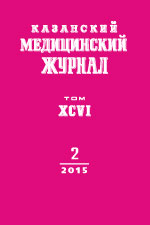Определение факторов риска развития ксеростомии у пациентов амбулаторного стоматологического приёма
- Авторы: Комарова К.В.1, Раткина Н.Н.1, Поленичкин В.К.1, Карманов Е.П.1
-
Учреждения:
- Новокузнецкий государственный институт усовершенствования врачей, Новокузнецк, Россия
- Выпуск: Том 96, № 2 (2015)
- Страницы: 174-177
- Раздел: Теоретическая и клиническая медицина
- Статья получена: 28.03.2016
- Статья опубликована: 15.04.2015
- URL: https://kazanmedjournal.ru/kazanmedj/article/view/1736
- DOI: https://doi.org/10.17750/KMJ2015-174
- ID: 1736
Цитировать
Полный текст
Аннотация
Цель. Определение факторов риска развития ксеростомии.
Методы. Обследованы 137 пациентов в возрасте от 25 до 60 лет (76 женщин и 61 мужчина), основную группу составили 40 пациентов с ксеростомией (29 женщин и 11 мужчин), медиана возраста - 44,5 года [38; 49,5]. Контрольную группу составили 97 пациентов без ксеростомии (47 женщин и 50 мужчин), медиана возраста - 42 года [36; 49]. Для сбора жалоб, анамнеза и определения факторов риска развития ксеростомии использовали анкету В.В. Афанасьева (1993). Качественные признаки представлены абсолютной величиной и долей (%). При оценке статистической значимости различий качественных показателей строились таблицы сопряжённости с последующим расчётом критерия χ2 Пирсона.
Результаты. 19 (47,5%) пациентов основной группы принимали медикаменты, влияющие на снижение саливации, длительность приёма составила от 1 до 4 мес. При анкетировании пациенты с ксеростомией статистически чаще отмечали заболевания сердечно-сосудистой системы (15 человек, 37,5%), желудочно-кишечного тракта (11 пациентов, 27,5%), эндокринной системы (10 человек, 25%), опорно-двигательного аппарата (9 пациентов, 22,5%). Сочетание трёх и более положительных ответов на вопросы анкеты В.В. Афанасьева выявлено у 12 (30%) пациентов основной группы, что статистически значимо отличалось от группы контроля - 1 (1,03%).
Вывод. Наиболее частыми причинами развития ксеростомии являются следующие факторы: приём лекарственных препаратов, заболевания сердечно-сосудистой системы, желудочно-кишечного тракта, опорно-двигательного аппарата, эндокринной системы; три и более положительных ответа на вопросы в анкете повышают вероятность выявления ксеростомии у респондента.
Ключевые слова
Об авторах
Ксения Владимировна Комарова
Новокузнецкий государственный институт усовершенствования врачей, Новокузнецк, Россия
Автор, ответственный за переписку.
Email: komarovakv@yandex.ru
Наталья Николаевна Раткина
Новокузнецкий государственный институт усовершенствования врачей, Новокузнецк, Россия
Email: komarovakv@yandex.ru
Владимир Кузьмич Поленичкин
Новокузнецкий государственный институт усовершенствования врачей, Новокузнецк, Россия
Email: komarovakv@yandex.ru
Евгений Петрович Карманов
Новокузнецкий государственный институт усовершенствования врачей, Новокузнецк, Россия
Email: komarovakv@yandex.ru
Список литературы
- Афанасьев В.В. Слюнные железы. Болезни и травмы. - М.: ГЭОТАР-Медиа, 2012. - 296 с.
- Вавилова Т.Н., Янушевич О.О., Островская И.Г. Слюна. Аналитические возможности и перспективы. - М.: БИНОМ, 2014. - 312 с. .
- Вейсгейм Л.Д., Гаврикова Л.М., Дубачёва С.Г. Применение средств гигиены полости рта Mexidol Dent для профилактики заболеваний слизистой оболочки полости рта у больных с ксеростомией // Стоматология. - 2014. - Т. 93, №3. - С. 15-17.
- Денисов А.Б. Слюна и слюнные железы. - М.: Издательство РАМН, 2009. - 472 с.
- Деркачева Е.И., Ронь Г.И. Клинические проявления в полости рта при ксеростомии // Урал. мед. ж. - 2014. - №5 (119). - С. 44-47.
- Комарова К.В., Раткина Н.Н., Поленичкин В.К. Способ оценки секреторной функции слюнных желёз // Казанский мед. ж. - 2013. - Т. 94, №2. - С. 245-246.
- Макеева И.М., Дорошина В.Ю., Аракелян М.Г. Ксеростомия и средства, облегчающие её проявление // Стоматология. - 2013. - Т. 92, №5. - С. 12-13.
- Панин А.М. Хирургическая стоматология. Воспалительные и дистрофические заболевания слюнных желёз. - М.: Литтерра, 2011. - 208 с.
- Villa A., Abati S. Risk factors and symptoms associated with xerostomia: a cross-sectional study // Austr. Dent. J. - 2011. - Vol. 56. - P. 290-295. http://dx.doi.org/10.1111/j.1834-7819.2011.01347.x
- Villa A., Polimeni A., Strohmenger L. et al. Dental patients’ self-reports of xerostomia and associated risk factors // J. Am. Dent. Assoc. - 2011. - Vol. 142, N 7. - P. 811-816. http://dx.doi.org/10.14219/jada.archive.2011.0269
Дополнительные файлы







